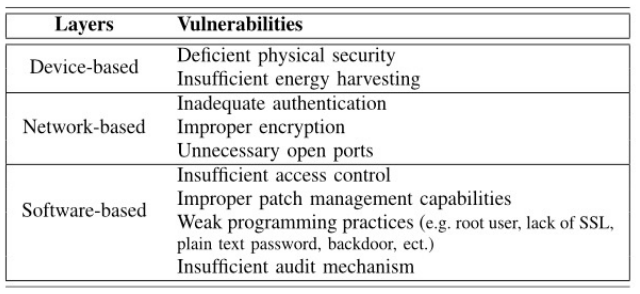Index
Introduction
Security Properties
- Confidentiality
- Integrity
- Availability
For more see at Cryptography
OSI Security Architecture
- Security Attack: Any action that compromises the security of information owned by an organization
- Security Mechanism: A process (or a device incorporating such a process) that is designed to detect, prevent, or recover from a security attack
- Security Service: A processing or communication service that enhances the security of the data processing systems and the information transfers of an organization
5D of Perimeter Security
- Deter: dissuade the potential attackers before they try to
compromise the security service
- Make attack difficult
- Detect: monitor for attacks
- IDS
- Deny: prevent unauthorised access
- Firewall, access control
- Delay: slow down the attacker
- maximize the time between the detection of the attack and the attack reaching the target
- Defend: fight with the attacker
- More suitable for physical security
- Drop malicious packets as close to the source as possible
Security Mechanisms
X.800
- Access control
- Enforce a policy of limiting access to a resource to only those users who are authorised
- Traffic padding
- Insertion of bits into gaps in a data stream to frustrate traffic analysis
- Notarisation
- Trusted third party to assure certain property of data exchange
- Security audit trail
- Data collected and potentially used to facilitate a security audit
- Security recovery
- Deals with requests from security mechanisms, such as event handling and management functions, and takes recovery actions
Security Policy
- Access control requirements: Only X may access Y.
- Actions required before the access: Gathering owner consent.
- Actions that must be performed within a certain time period: Inform data owner whether the data is used.
- Restriction of purposes for which data may be used: Statistical purposes only.
- Limitations on retention time: Delete after 7 days.
- Mandatory use of protection mechanisms: Encrypt backups.
- Duties of keeping the data up-to-date: Update every 30 days.
Security Attack
Jamming
- takes up the transmission channel regardless of the rules specified by network protocols
- affects availability for legitimate packets
Sniffing
- Listening to the network conversations that are not intended for you
- Network interface card (NIC) can be set to promiscuous mode to get all packets from network
- Packet sniffers intercept and log network traffic that they can see via the NIC
Spoofing
- Masquerading/impersonation – pretend to be somebody you are not
TCP/IP Architecture
| Physical Layer | Data Link Layer | Network Layer | Transport Layer | Application Layer |
|---|---|---|---|---|
| Wired/Wireless | MAC | IPv4/IPv6 | TCP/UDP/… | HTTP/… |
Physical Interception
Passive Interception: promiscuous mode (The network must broadcast all packages such as wireless) Active Interception: port mirroring, network tapping
Traffic Analysis
Data Acquisition
Data acquisition is the process of understanding the meaning of the captured traffic
BPF (Berkeley Packet Filter)
Problem:
- Packet filter module sits on top of packet capture module
- Each packet received is copied always, to a buffer, which is then sent upstream to the packet filter, which may decide to discard the packet.
- Many CPU cycles will be wasted copying unwanted packets
BPF solution:
- Filter the packet before buffering the required parts of it
- The filter is defined by users (which are network sniffers here)
- 100 times faster than the existing packet capture tool at the time
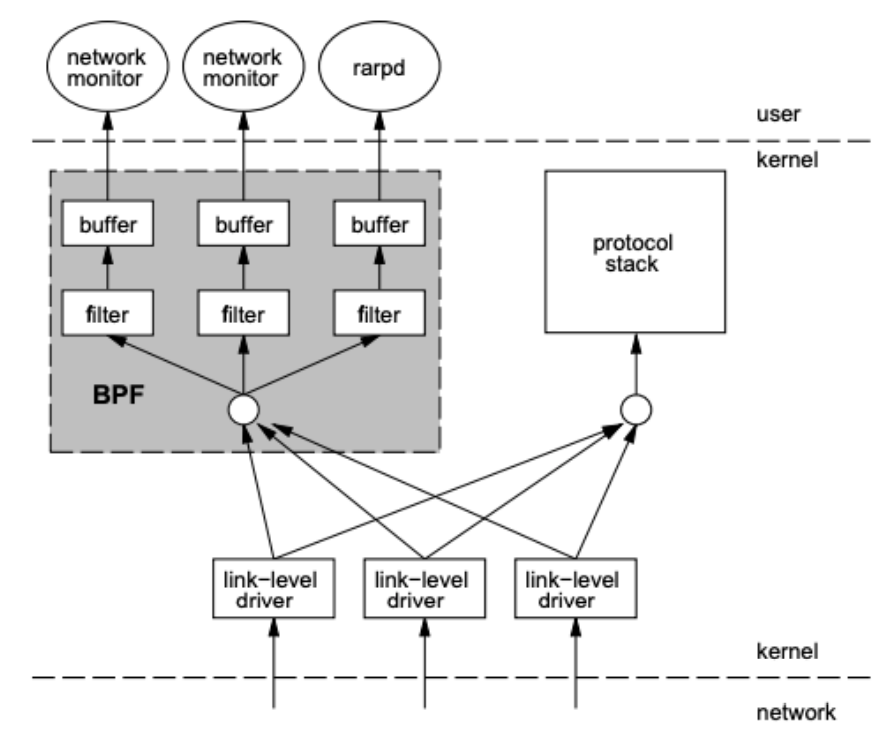
- BPF feeds the packet to each participating process’ filter. This user-defined filter decides whether a packet is to be accepted and how many bytes of each packet should be saved.
- For each filter that accepts the packet, BPF copies the requested amount of data to the buffer associated with that filter.
Traffic Analysis
Types of traffic analysis
- Protocol analysis: analyse individual protocol inside a packet
- Packet analysis: analyse protocols of different layers inside a set of
packets
- Pattern matching
- Identify packets of interest by matching specific values in the packet capture
- E.g., if source IP address = foo
- Parsing protocol fields
- Extract the contents of particular protocol fields
- E.g., Wireshark shows the contents of each field in an IP packet
- Packet filtering
- Separate packets based on the values of fields in protocol metadata
- E.g., showing ICMP packet only
- Pattern matching
- Flow analysis: analyse a flow composed of multple packets
- List conversations and flows
- List all conversations and/or flows within a packet capture or only specific flows based on their characteristics
- Export a flow
- Isolate a flow or multiple flows, and store the flow(s) of interest to disk for further analysis
- File and data carving
- Extract files or other data of interest from the reassembled flow
- List conversations and flows
Network Attacks
ARP Spoofing
ARP
- To avoid having to send an ARP request packet each time by broadcasting, a host can cache the IP and the corresponding MAC address in its ARP table (ARP cache)
- Each entry in the ARP table is usually “aged” and contents are erased if no activity occurs within a period
- ARP table is updated when hearing an ARP request or ARP reply
- ARP is a stateless protocol, so most operating systems will update their
table
- If a request is received, regardless whether they are the target
- If a reply is received, regardless whether they have sent out an actual request
Attack
- Construct spoofed ARP replies and actively join the ARP protocol run
- A target computer A could be convinced to send frames destined for computer B to the attacker instead
- Computer A will have no idea that this redirection took place
Application
- MitM In cryptography and computer security, a man-in-the-middle attack is a cyberattack where the attacker secretly relays and possibly alters the communications between two parties who believe that they are directly communicating with each other.
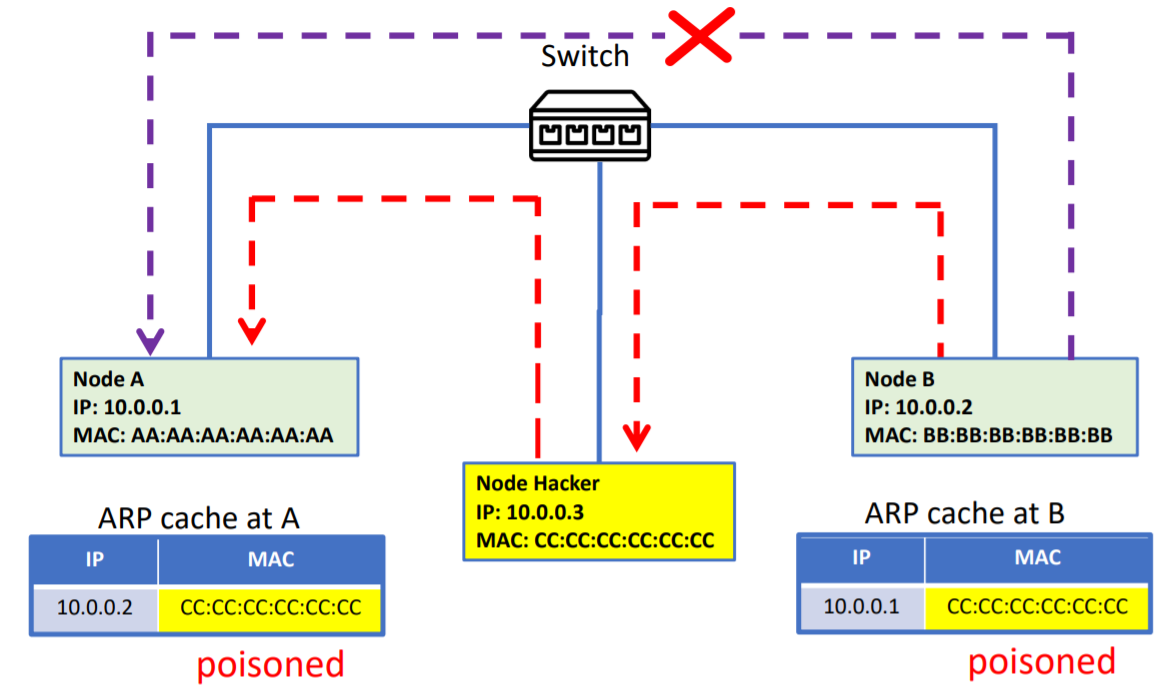
- MAC Flooding
- Switches have an internal CAM (Content Addressable Memory) table, which maps switch ports to MAC addresses.
- When a frame arrives at switches, this lookup table is checked to know which port to forward each specific packet out of where the receiver is located
- In a MAC flooding attack, a switch is fed many Ethernet frames, each containing different spoofed source MAC addresses to consume the limited memory in the switch
DHCP Starvation
DHCP Protocol
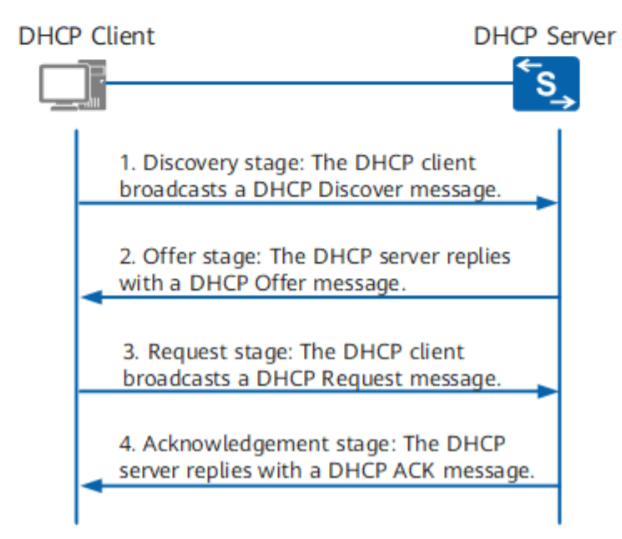
- Discovery: client broadcast message to discover the server
- Offer: server unicast message offering IP
- Request: client accepting the IP offered
- Acknowledge: server acknowledges the IP and sends other related configuration
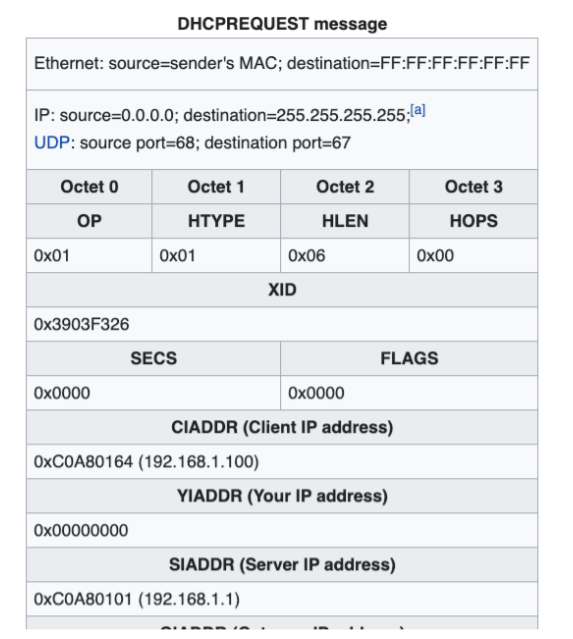
Attack
-
If the legitimate DHCP server in the network starts responding to all bogus DHCP_REQUEST messages with random generated MAC address, available IP addresses in the DHCP server scope will be depleted within a very short span of time.
-
Once the available number of IP addresses in the DHCP server is depleted, network attackers could set up a bogus DHCP server and respond to new DHCP DISCOVERY message from network DHCP clients
-
The rogue server starts distributing IP addresses and other TCP/IP configuration settings including default gateway and DNS server IP addresses, which can now point to an IP address controlled by the attacker. Facilitates man-in-the-middle attack and sniffing attacks
ICMP Smurfing
Smurfing: amplification
Small amount of traffic are converted into large amounts of
traffic, in order to attack the target
Spoofed ECHO_REQUEST
- Smurf malware is used to generate a fake Echo request, containing a spoofed source IP, which is actually the target server address
- The request is sent to an intermediate IP broadcast network
- The request is transmitted to all of the network hosts on the network
- Each host sends a ping response (ICMP ECHO_REPLY) to the spoofed source address
- With enough ICMP ECHO_REPLY forwarded, the target server is brought down which causes denial of service (DoS)
NTP (Network Time Protocol) Amplification DDoS Attack
- The attacker uses a botnet to prepare NTP request packets with spoofed addresses to NTP servers, which have their monlist command enabled. The spoofed IP address is the victim’s IP address
- The botnet sends the NTP request (a UDP packet) to NTP servers using its monlist command, resulting in a large response
- The server responds to the spoofed address with the resulting data, normally of much larger size than the original NTP request
- The victim receives the response and the surrounding network infrastructure becomes overwhelmed with the amplification of traffic, resulting in a DoS attack.
TCP SYN Flooding
SYN is the initial package that establishing the connection
For TCP see at Computer Network (Chinese Version)
-
The attacker, who is a botmaster here, instructs the bots to send a high volume of SYN packets to the targeted server, often with spoofed IP addresses.
-
The server then responds to each one of SYN packets and leaves an open port ready to receive the response
-
While the server waits for the final ACK packet, which never arrives, the attacker continues to send more SYN packets. The arrival of each new SYN packet causes the server to temporarily maintain a new open port connection for a certain length of time, and once all the available resources have been utilised the server is unable to function normally.
TCP Session Hijacking
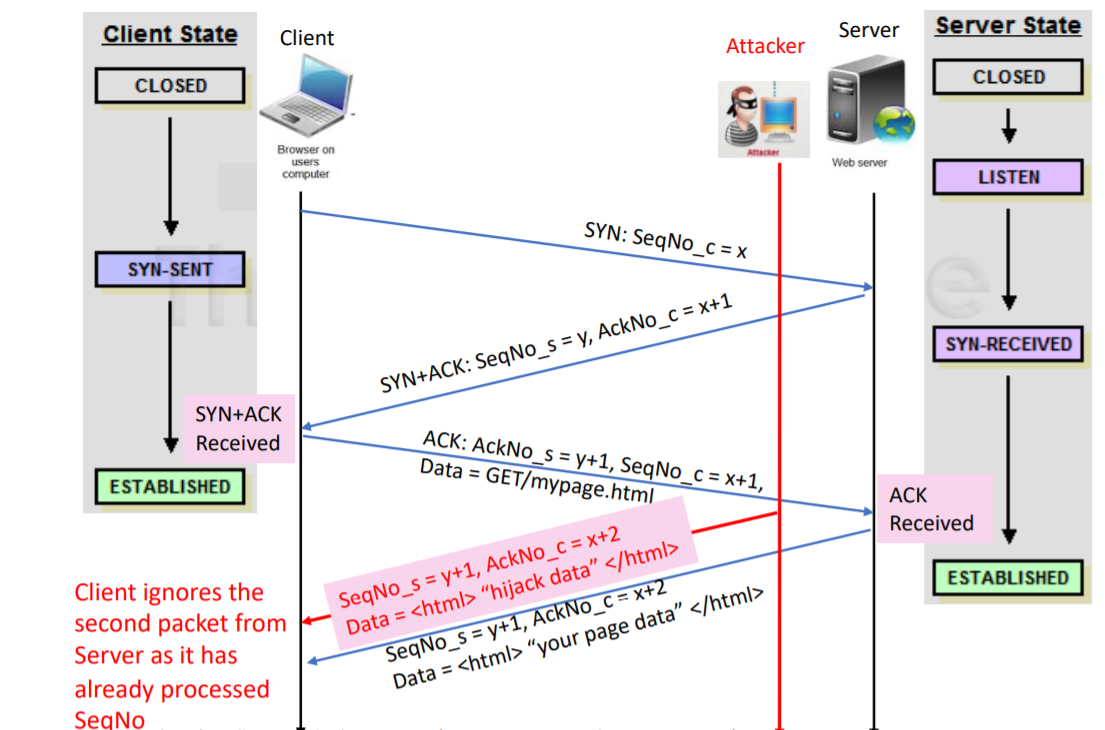
- Source IP address + port number
- Destination IP address + port number
- Sequence number
The attacker could also pretend to be the client to ask data from server.
Off-path Hijack
- Blindly spoofs as the client, and sends a SYN packet to the server as if it was from the client
- The attacker must get the sequence number correct
Guess the initial seq num:
- Unfortunately, BSD Unix TCP/IP stack did not adhere to these recommendations.
- The sequence number for BSD TCP/IP stacks increases by 128,000 every second and by 64,000 for every new TCP connection.
- Such a sequence is relatively easy to predict and can be much more readily exploited than one which follows the RFC standard
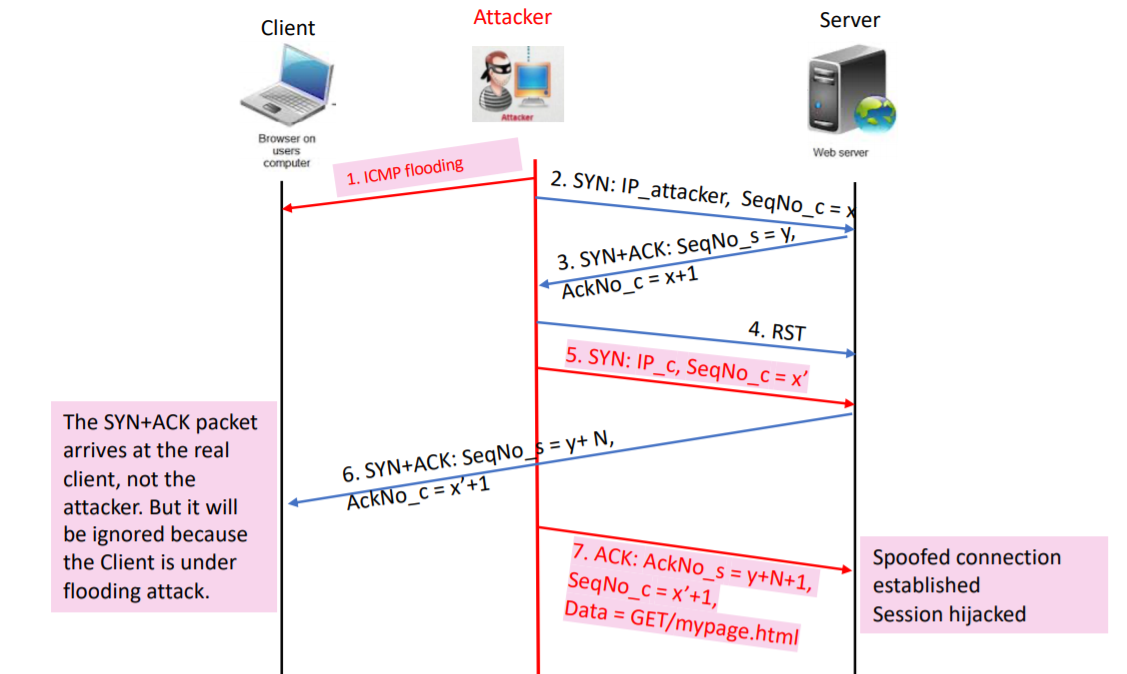
What the attacker does
- Swamp the Client C with ICMP flooding, taking it out of the picture (because the attacker wants to spoof as C)
- Create a real connection to port 80 on the web Server, and record the sequence number returned by the web Server.
- Close the connection with the Server.
- Create a raw IP socket, change its protocol to that of TCP, and change its source IP to that of the Client (by writing in the kernel)
- Send a SYN packet (supposedly from the Client) to port 80 on the web server.
- The server then sends an SYN+ACK to the Client C, which is silently ignored because C is under ICMP flooding attack
- Send an ACK packet to the server with the acknowledgement number equal to the sequence number previously recorded plus N+1
After connection is established and hijacked
- Send data to the Server, taking care to increment the sequence number each time by the amount of data sent. The Server thought the data comes from the Client.
BGP Route Hijacking
- Autonomous System: On the Internet, an autonomous system (AS) is the unit of router policy, either a single network or a group of networks that is controlled by a common network administrator (or group of administrators) on behalf of a single administrative entity (such as a university, a business enterprise, or a business division).
- An autonomous system is also sometimes referred to as a routing domain.
- An autonomous system is assigned a globally unique number, sometimes called an Autonomous System Number (ASN).
- ASs perform longest prefix matching to select which neighbours to route through
Attack
- BGP prefix hijacking
- When an AS announces route to network prefixes that it does not actually control
- Such false information is added to routing tables in BGP routers across the Internet
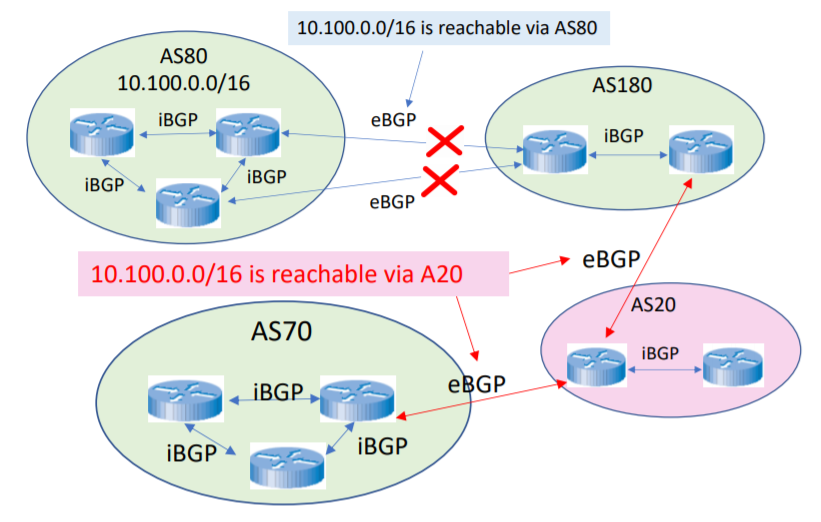
- BGP sub-prefix hijacking
- The attacker lies about a subset of the prefix rather than the whole prefix belonging to another AS
- The false route is chosen because BGP prefers longest prefix matching

DNS Cache Poisoning
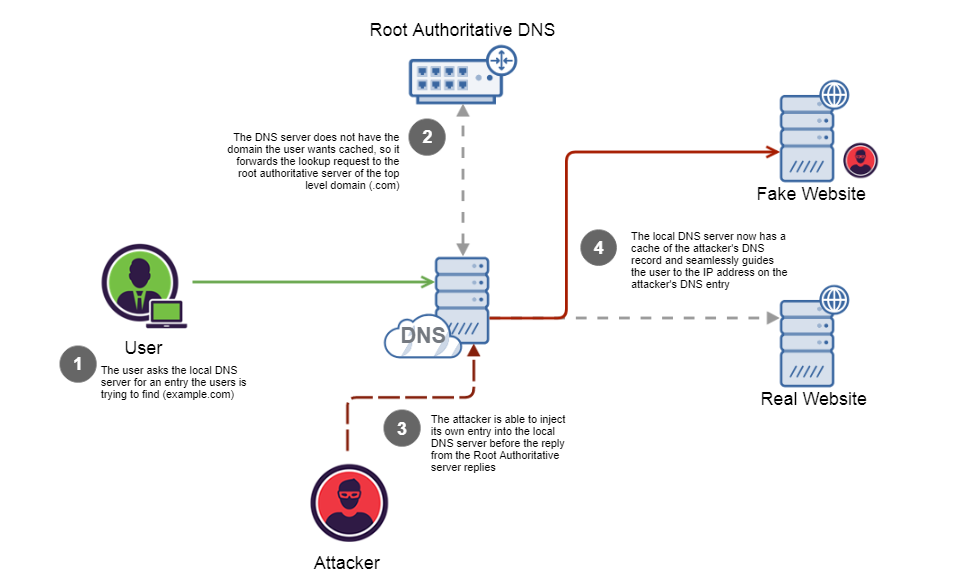
- Query QID Attack
- Every DNS query has a QID
- DNS use connectionless UDP
- If the attacker responds to query with the right QID, then it wins, over the real nameserver’s response!
- RRSet attack
- DNS response contains different Resource Record Sets, or RRSets.
- In particular, an “additional” section, where name server can give additional info that may be “useful” for future lookups
- In an iterative query, the .com nameserver says you can ask ns.example.com for the IP address of example.com. To help next request, an additional record might give IP for ns.example.com.
- Darth abuses this feature and adds a record that says the IP address of victim.com is 88.88.88.88
- FIX: Bailiwick checking (when asking for www.google.com, do not allow www.victim.com to be accepted as an additional record)
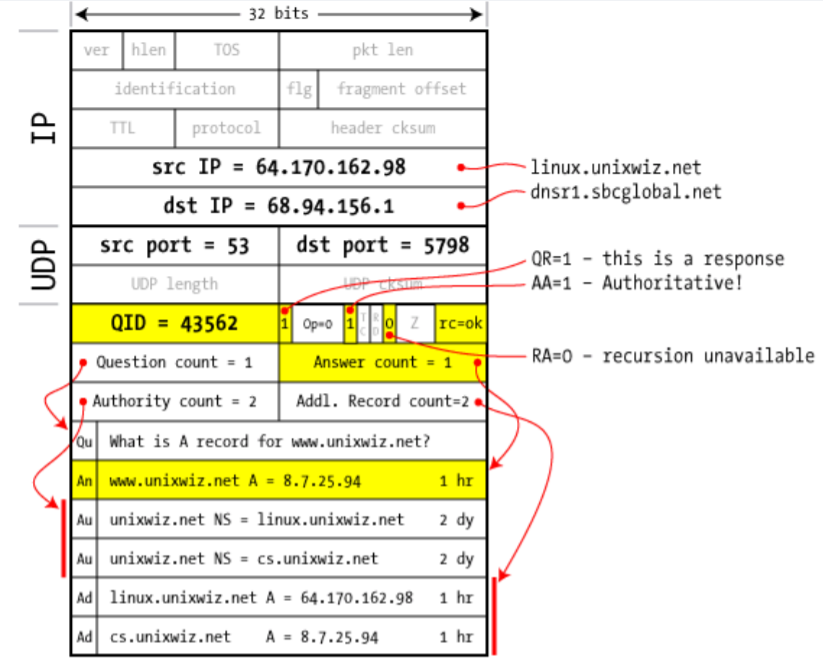
Firewall
Objectives
- Attempts to prevent bad things from happening (such as users sending company secrets outside, or outside people breaking into system inside)
- Without preventing good things from happening (such as employees accessing information available externally)
Main task: Access Control
Techniques for firewalls to control access
- Service control (what): determines the types of Internet services that can be
accessed, inbound or outbound
- Internet service/applications are provided through transport layer ports
- Direction control (where): determines the direction in which particular service requests may be initiated and allowed to flow through the firewall
- User control (who): controls access to a service according to which user is attempting to access it
- Behaviour control (how): controls how particular services are used
Firewall Types
- A firewall can operate as
- A positive filter, passing only packets that meet specific criteria
- The assumption is everyone is a baddy
- A negative filter, rejecting any packets that meet specific criteria
- The assumption is everyone is a goody
- A positive filter, passing only packets that meet specific criteria
- Depending on the type of firewall, it may examine
- One or more protocol headers in each packet
- They payload of each packet, or
- The pattern generated by a sequence of packets
Limitations
Canot protect
- From attacks bypassing it
- Against malware imported via laptop, PDA, storage infected outside
- Against access via WiFi networks if improperly secured against external use
- Against internal threats
Packet Filtering Firewall
- Examines each IP packet and permits or denies the packet according to rules
- Applies a set of rules to each incoming and outgoing IP packet and then forwards or discards the packet
- The firewall is typically configured to filter packets going in both directions
Filter Rules
- A packet filtering firewall is typically set up as a set of rules based on matches to fields in IP or TCP header.
- In each set, rules are applied top to bottom.
- If there is a match to one of the rules, that rule is invoked to determine whether to forward or discard the packet.
- If there is no match to any rule, then a default action is taken.
Default = discard
- Positive filtering
- Use a whitelist
- That which is not expressively permitted is prohibited
Default = forward
- Negative filtering
- Use a blacklist
- That which is not expressively prohibited is permitted
Pros and Cons
Pros
- Very simple
- Typically are transparent to users and are very fast
Cons
- No examination of upper-layer data, hence no prevention of attacks that employ application-specific vulnerabilities or functions.
- Because of the limited information available to the firewall, the logging functionality present in packet filter firewalls is limited.
- Most packet filter firewalls do not support advanced user authentication schemes (also due to lack of upper-layer functionality).
- Generally vulnerable to attacks and exploits that take advantage of problems within the TCP/IP specification and protocol stack, such as network layer address spoofing.
- Due to the small number of variables used in decisions, packet filtering firewalls are susceptible to security breaches caused by improper configurations
attacks and countermeasures
IP address spoofing
- The intruder transmits packets from the outside within a source IP address field containing an address of an internal host.
- Fake source address to be trusted
- Attacker hopes that use of a spoofed address will allow penetration of systems that
employ simple source address security, in which packets from specific trusted internal
hosts are accepted.
Countermeasure - Add filters on router to block such packets
- Discard packets with an inside source address if the packet arrives on an external interface
- This countermeasure is often implemented at the router external to the firewall
Source routing attack
- Source routing: In the Internet, there is an option for the the sender of a packet (the source node) to include information in the packet that tells the route the packet should take to get to its destination.
- Source routing is seldom used, only in debugging network problems or easing network congestion control
- An attacker can generate traffic claiming to be from inside the firewall (although the packet is sent from outside)
- Attacker specifies the route that a packet should take as it crosses the Internet, in the
hopes that this will bypass security measures that do not analyse the source routing
information
Countermeasure - Block source routed packets
- Discard all packets that use this option
Tiny fragment attacks
- Split headers information over several tiny packets
- Attacker uses the IP fragmentation option to create extremely small fragments and force the TCP header information into a separate packet fragment.
- Attack designed to circumvent filtering rules that depend on TCP header information.
- Typically, a packet filter makes a filtering decision on the first fragment of a packet.
- Attacker hopes that the filtering firewall examines only the first fragment and that the
remaining fragments are passed through.
Countermeasure - Discard all packets which use the TCP protocol and is fragmented
- Enforce a rule that the first fragment of a packet must contain a predefined minimum amount of the transport header.
Intrusion Detection and Prevention Systems
- An IDS’s main function is to detect and report intrusion attempts to the network.
- An IDS is a security camera after the gate.
- An IDS alerts any intrusion attempts to the security administrator
Terms
- Intrusion: unwanted and unauthorised intentional access of computerised network resources
- Intrusion detection: detecting unauthorised use of a system or network, detecting attacks upon a system or network
- Intrusion detection system (IDS): does for network what anti-virus software
does with incoming files
- Components: sensors, alerts
- Intrusion prevention system (IPS): an IDS with an automated response
- Shut down attacker connections
- Try to back-trace attacker
- Counter-attack
Detection Rate
See at Evaluation
$Sensitivity = True Positive Rate = Detection Rate = \frac{TP}{TP + TN}$
$Specificity = True Negative Rate = \frac{TN}{TN + FP}$
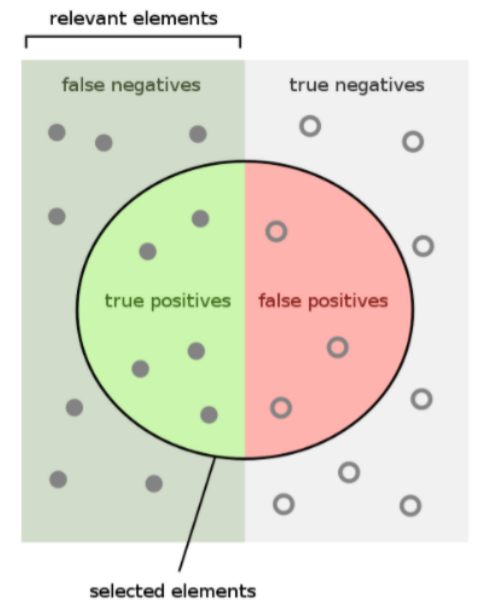
Intrusion Detection
- Reputation detection
- Detect host communication with someone of bad reputation
- Idea: detect host communicating with someone with bad reputation
- Based on (public or private) blacklists
- Anomaly-based detection
- Normal system behaviour is defined first
- Involves the collection of data relating to the behaviour of legitimate users over a period of time
- Then statistical tests are applied to observed behaviour to determine whether that behaviour is not legitimate user behaviour
- Threshold detection: this approach involves defining thresholds, independent of user, for the frequency of occurrence of various events
- Profile based: a profile of the activity of each user is developed and
used to detect changes in the behaviour of individual accounts
- Focuses on characterising the past behaviour of the user or a group of users and then detects significant variations.
- Can be thought as the whitelist in firewall rule
- Misuse-based detection
- Abnormal system behaviour is defined first
- Involves an attempt to define a set of rules or attack patterns that can be used to decide that a given behaviour is that of an intruder
- Advantages
- Generate few false alarms
- Provides an explanation for alerts
- It is fast
- It is (more) resilient to evasion
- Disadvantage
- It detects only known attacks
- It needs continuous updating
- It is vulnerable to over-stimulation attacks
IDS classification
- Timeliness:
- Real-time (on-line, continuously running)
- Non real-time (off-line, periodic)
- Response type:
- Passive (generates alerts)
- Active (blocks malicious traffic)
- State-dependency:
- Stateful analysis
- Stateless analysis
- System type:
- Software
- Hardware
How an IDS works
- Input information
- Application-specific information: correct data flow, etc.
- Host-specific information: local logs, syscalls, file system changes
- Network-specific information: packets, etc
- Intrusion detection policies
- Known bad: blacklist with known attacks or attackers
- Reputation-based detection
- Signature-based/rule-based/misuse-based detection
- Known good: alert anything out of usual
- Anomaly-based detection
- Known bad: blacklist with known attacks or attackers
- Response on intrusions
- Passive response
- Active response
Honeypots
- A honeypot is a trap set to detect, deflect, or in some manner counteract attempts at unauthorised use of information or network systems
- Honeypots are decoy systems that are designed to lure a potential attacker away from critical systems
- It can be viewed as an intrusion detection technique used to
- Learn from unknown attacks
- Study intruders modus operandi
- Better identify, understand and protect against threats
- Traffic landing in a honeypot is unsolicited
- Flexible tool with multiple applications
- Prevention
- Detection
- Information gathering
Classification
- By purpose
- Production honeypots:
- Meant to be used in production environments of companies
- Characterised by ease of deployment and utilisation
- Trade-off between ease of operation and the quantity of collected information
- Research honeypots
- Provide comprehensive information about attacks
- More difficult to deploy
- Production honeypots:
- By level of interaction
- Low interaction honeypots
- Emulates a small set of services, applications
- Cannot be exploited to get complete access to the honeypot
- The attacker is limited to the level of emulation
- Tend to be production honeypots
- Advantages: low risk, easy to deploy/maintain
- Disadvantages: they capture limited information
- High interaction honeypots
- Use real operating system and applications
- Attacker gain full access at network/system
- Tend to be research honeypots
- Advantages: capture extensive information
- Disadvantages: high risk and time intensive to maintain
- Low interaction honeypots
- By implementation
- Physical honeypot:
- A real machine on the network
- Virtual honeypot:
- Simulated or virtualised by a host machine that forwards the network traffic to the virtual honeypot
- Multiple virtual honeypots can be simulated on a single host
- Usually high-interaction honeypots
- Physical honeypot:
- By direction of the interaction
- Server honeypots
- Client honeypots
Honeypots Workflow
Phase: data control
Honeypots control and contain the activities of an attacker by interacting with the attacker through network protocols
Phase: data capture
-Honeypots monitor and log all of the activities of an attacker within the honeypot
- Keep it all at all levels
- Stores all captured data in one central location
Phase: data analysis
- Honeypots analyse the data being collected
- Human-driven analysis
- Rely on automated tools to process the data
- Machine-driven analysis
- Assume that network connection are either
- Malicious
- anomalous
- Assume that network connection are either
Honeytoken
- Honeytokens are honeypots that are not computer system but
- An unused email address
- A fake database entry
- etc
- Their value lies not in their use, but in their abuse
- Key idea
- Their use is inherently suspicious
- Necessarily malicious
IPsec
Security Association
- A security association (SA) is a one-way relationship between sender and receiver defining security services
- SA specifies things like:
- Authentication algorithm (AH)
- Encryption algorithm (ESP)
- Keys
- Key lifetimes
- Lifetime of security association
- Protocol mode (tunnel or transport)
- SA is uniquely identified by three parameters:
- Security Parameters Index (SPI): a bit string assigned to this SA and having local significance only. SPI is carried in AH and ESP headers to enable receiving system to select SA under which a received packet will be processed.
- IP destination address: address of destination endpoint of SA (may be an end-use system or a network system such as a firewall or router)
- Security Protocol Identifier: a field from the outer IP header that indicates whether the SA is an AH or ESP SA.
Authentication Header (AH)
Header:
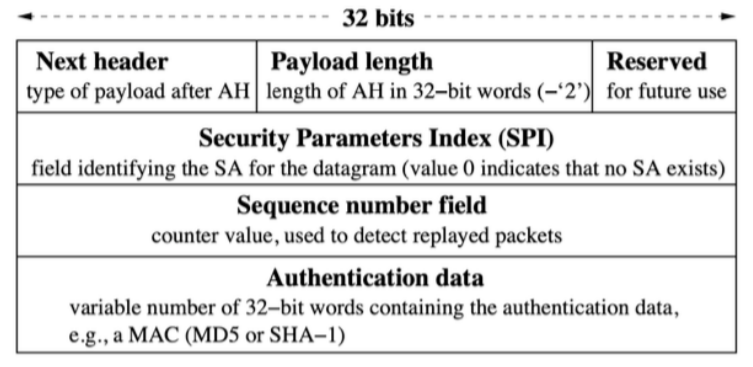
Two Modes:
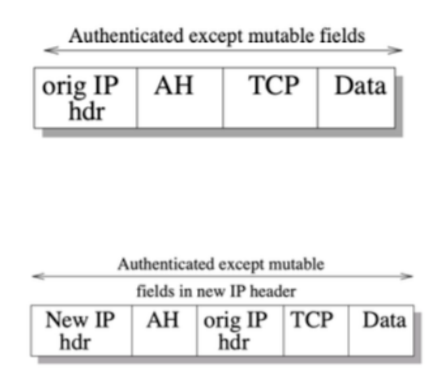
Encapsulating Security Payload (ESP)
Header:

Transport Mode:
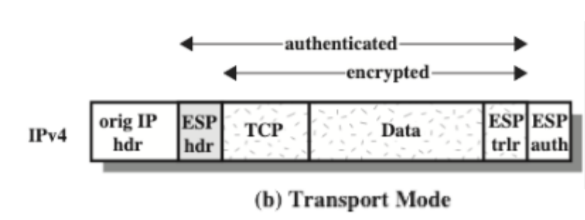
Tunnel Mode:

Internet Key Exchange (IKE)
Perfect Forward Secrecy (PFS)
A property of key-agreement protocols ensuring that a session key derived from a set of long term keys cannot be compromised if one of the long-term keys is compromised in the future. The key used to protect transmission of data must not be used to derive any additional keys, and if the key used to protect transmission of data is derived from some other keying material, then that material must not be used to derive any more keys. In this way, compromise of a single key permits access only to data protected by that single key.
The trick to achieving Perfect Forward Secrecy is to generate a temporary session key, not derivable from the information stored at the node and forgotten after the session concludes.
SSL/TLS

For vulnerability see ssl vulnerabilities
User Interface Vulnerability
- Users don’t understand lock=SSL
- Users never click on the lock
- Users don’t understand certificates
- Confusion over warning messages
Privacy and Anonymity
- Privacy:
- A state in which one is not observed or disturbed by others
- You choose what you let other people know.
- Confidentiality of information that you don’t want to share.
- Anonymity:
- A condition in which your true identity is not known.
- Confidentiality of your identity.
- Unobservability of our actions when they occur.
Anonymity
Attacks
- Passive traffic analysis
- Infer from network traffic who is talking to whom
- To hide your traffic, you must carry other people’s traffic!
- Active traffic analysis
- Inject packets or put a timing signature on packet flow
- Compromise of network nodes (routers)
- It is not obvious which nodes have been compromised
- Attacker may be passively logging traffic
- Better not to trust any individual node
- Assume that some fraction of nodes is good, but don’t know which
Requirement: anonymise the sender and/or the receiver
- Provide confidentiality of principal’s identities
- Linkage to actual identity only in restricted cases
- IT equivalent: online usernames
- Pseudonyms need sometimes to be resolved into the proper (underlying) names
- But naming and name resolution can be quite problematic.
Mix Networks
- Public-key cryptography plus trusted re-mailer (Mix)
- Public keys used as persistent pseudonyms.
- Untrusted communication medium: designed to work in environment with an
active attacker who
- Can learn origin, destination(s), and representation of all messages in the communication system;
- Can inject, remove, or modify messages;
- However, cannot determine anything about the correspondence between a set of encrypted items and the corresponding set of unencrypted items, or create forgeries.
Single Mix
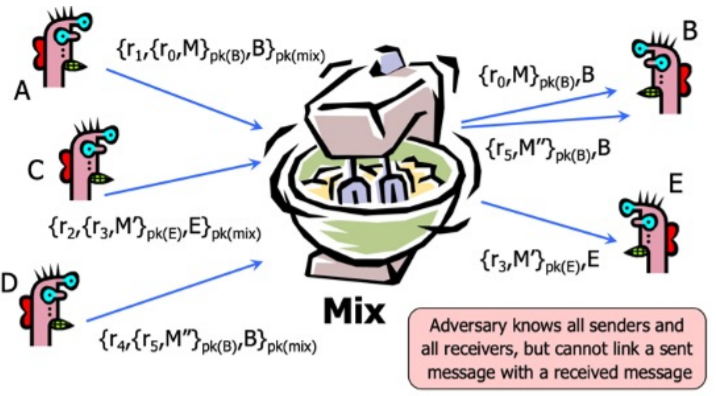
For sending message M to agent at address B
$\{r_1, \{r_0, M\}_{pk_b}, B\}_{pk_{mix}} \rightarrow \{r_0, M\}_{pk_b}, B$
- Input to Mix on left hand side of $\rightarrow$
- Mix generates output on right hand side and sends first component to B
- $r_i$ are padding strings of random bits
- This is just a variant of single proxy, with padding and encryption
- Mix also performs additional operations to foil traffic analysis
Foiling Traffic Analysis Requirements
- Agents/mixes work with uniformly sized items i.e., messages split (or padded) into fixed size blocks
- Order of arrival hidden by outputting items in batches
- Can use fix ordering (e.g., lexicographic) or random ordering
- Repeated information must be blocked
- So mixes must filter duplicates, cross-checking across batches
- Or string r include, e.g., a time stamp
- Sufficient traffic from a large anonymity set is required
- Few clients sending entails weak anonymity
- Solution involves clients regularly sending (and receiving dummy messages).
Untraceable Return Addresses
- To respond to an anonymous sender x with a return message $M’$
- Single Mix case (with key $pk_{mix_1}$)
- Sender includes “return address”: $\{r_1, A_x\}_{pk_{mix_1}}, pk_x$
- $r_1$ is a random string that can also be used as a shared key
- $pk_x$ is a fresh public key, created for this purpose
- $A_x$ is x’s actual address
- Receiver sends to the “response” Mix: $\{r_1, A_x\}_{pk_{mix_1}}, \{r_0, M’\}_{pk_x}$
- Sender choose path of the responding message
- The “response” Mix transforms this to
- Second part sent to: $A_x$
- Sender includes “return address”: $\{r_1, A_x\}_{pk_{mix_1}}, pk_x$
- Encryption with $r_1$ masks input/output correlation $A_x, \{\{r_0, M’\}_{pk_x}\}_{r_1}$
- Only the original sender can decrypt as he created both $pk_x$ and $r_1$
Generalized Format
-
Sender includes “return address”:
$\{r_1, \{r_2, …, \{r_n, A_x\}_{pk_{mix_n}}\}_{pk_{mix_2}}\}_{pk_{mix_1}}, pk_x$
-
Receiver sends to the “response” Mix:
$\{r_1, \{r_2, …, \{r_n, A_x\}_{pk_{mix_n}}\}_{pk_{mix_2}}\}_{pk_{mix_1}}, \{r_0, M’\}_{pk_x}$
-
Result of 1^{st} Return Mix:
$\{r_2, …, \{r_n, A_x\}_{pk_{mix_n}}\}_{pk_{mix_2}}, \{\{r_0, M’\}_{pk_x}\}_{r_1}$
-
Final result:
$A_x, \{\{\{\{r_0, M’\}_{pk_x}\}_{r_1}\}_{r_2} …\}_{r_n}$
Attacks
- (n-1) attack
- What happens if an attacker knows (e.g., has sent himself) n-1 of the n messages input to a mix?
- Performed by flooding a node with fake messages alongside a single message to be traced.
- The attacker can recognise her messages and therefore link the sender with the receiver of the single message under surveillance.
- This is an active attack
Dining cryptographers (DC)
- Each of the three cryptographers $C_1, C_2$ and $C_3$ flips an unbiased coin keeping the result $b_i$ secret ($i \in \{1,2,3\}$).
- Each cryptographer whispers the result $b_i$ in the ear of the person to their immediate left.
- Each cryptographer computes $d_i = b_i \oplus b_{i-1}$, where § where $b_i$ is the cryptographer’s own coin flip and § $b_{i-1}$ is the coin flip of the person on the right § Note that $d_0 = d_3$ and $b_0 = b_3$
- A cryptographer that did not pay for the meal announces her own $d_i$ A cryptographer that did pay for the meal lies by announcing the negation of $d_i$ i.e., $d_i \oplus 1$.
Wireless and IoT security
Wireless security risk factors
- Channel:
- Wireless networking typically involves broadcast communication, which is far more susceptible to eavesdropping and jamming than wired network
- Wireless networks are also more vulnerable to active attacks that exploit vulnerabilities in communications protocols
- Mobility:
- Wireless devices are far more portable and mobile than wired devices
- Resources:
- Some wireless devices, such as smartphones and tablets, have sophisticated operations systems but limited memory and processing resources with which to counter threats, including DoS and malwares
- Accessibility:
- Some wireless devices, such as sensors and robots, may be left unattended in remote and / or hostile locations
- This greatly increases their vulnerability to physical attacks
802.11i Operation
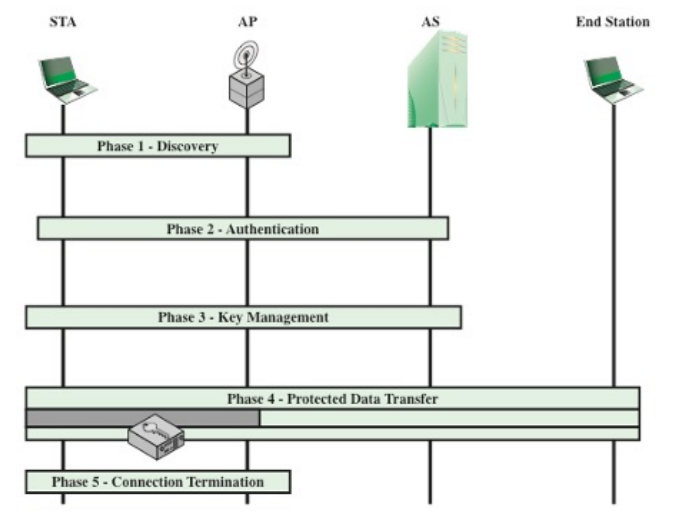
IoT Security
IoT Architecture
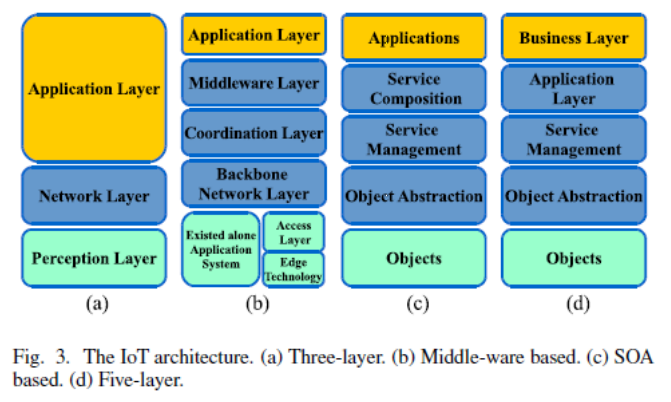
IoT vulnerabilities by layers
- Device-based: vulnerabilities associated with the hardware
- Network-based: vulnerabilities caused by weakness originated from communication protocol
- Software-based: vulnerabilities related to the firmware and/or the software of IoT device.
